Thursday: August 9th
The morning after the 2.5" deluge of rain I awoke to the pitter-patter of more rain on the tent fly.
It was now 5:30, my usual time to rise. I lay there thinking about packing up in the rain. Shortly thereafter, I got up, rousted Betsy out and then began to dismantle camp. We rolled the tent up into one big soggy mess. As we tossed it into the van I cursed myself for not a having a large trash bag handy for just such an event. In went the bedding, coolers and all the other camping paraphernalia. In short order we were packed up. We then went over to the shower house were I had set up the coffee pot. It was on a timer and was ready and waiting for us. We huddled under the overhang, drank our coffee and munched on the home made whole wheat banana bread we had brought along. The time was now about 6:30 am and there was a steady drizzle as we said farewell to Lake Louise.
We drove the 1.5 miles south to LeRoy and then picked up SR 56 and headed northwest. 25 miles later we were on Interstate 90 and heading west. At some point we stopped at a MickyD's and got coffee and grub. The rain had lessened as we travelled west and NPR reported the rain was in central Minnesota only and moving east. This sounded promising.
By the time we reached the crossroads of I-95 and I-35 at Albert Lea we were seeing patches of blue and the occasional soybean field lit up by the early morning sun.
Our destination for this morning was the far southwest corner of Minnesota. Here we would explore a region where a particular type of rock is surficially exposed as boulders, pavement and sharply vertical cliff faces. The geologists refer to this rock as Sioux Quartzite.
While driving we had a discussion about the best place to stay for the next couple of nights. We decided upon the town of Luverne. Here we would be centrally located in the area we wanted to explore.
We exited I-90 and then began the hotel search. First off we saw the 44 room Comfort Inn jammed right up against the interstate. No thanks.
We rolled on into town and saw the Cozy Rest and signs for both the Sunrise Motel and the Hillcrest Motel. We went on up to see the Hillcrest. The woman there showed us a room with 3 beds which went for $56 a nite. Why three beds? No matter - on to the next place.
We went back and found the Sunrise Motel. It was a small mom and pop which was obviously closed.The empty lot and "No Vacancy" sign were our first clues.
On to the Cozy Rest. The woman there was brusque, bordering on rude. To top it off the rates were higher than the Hillcrest.
So, it was back up to the Hillcrest where we registered for two nights. The woman there was professional, friendly and helpful. We unloaded a few things, refilled the water bottles and were then back out the door and on our way.
First stop - Blue Mounds State Park, a prairie park.
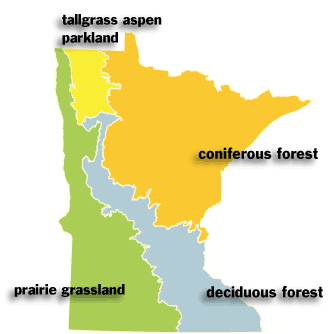
As you can see from the above Minnesota Biomes map, we are leaving the Mixed Oak savanna and prairie behind. Now, trees of any kind will be a rarity.
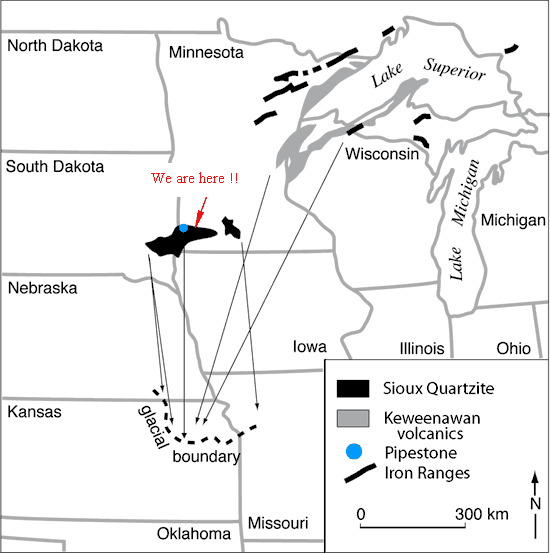
Source: Kansas Geological Survey, Public Outreach
Here is the area of interest and what WikiPedia has to say about it.
The Sioux quartzite was primarily formed by braided river deposits, of quartz arenite composition, with 95% of the rock being composed of rounded, fine to medium (0.125–0.5 mm) sand-size quartz grains.
The rivers are believed to flow southeast, at a relatively shallow gradient. Its basal conglomerate is thought to be braided stream deposits that are more proximal to the source, and there is possible marine influence on the upper part of the unit - this interpretation is supported by evidence of marine sediments (shales and banded iron formations) atop its correlative unit in Baraboo, Wisconsin. In addition, the unit contains ~1 meter beds of claystone, which are known as Catlinite or Pipestone, because these beds were used by the natives of the area to carve pipe bowls.
It is thought that the Sioux Quartzite and its correlative units are parts of a once-laterally-extensive sedimentary wedge that covered the then-southern passive margin of the North American craton.Source: WikiPedia
This rock is sometimes referred to as Pink Quartzite and is sold as decorative rock mulch in 50lb bags as "Tiffany Pink" and "Pink Starburst". What marketing! And, of course, it is has been the source of building material for many structures over the years including the monumental Sioux Falls Federal Building.
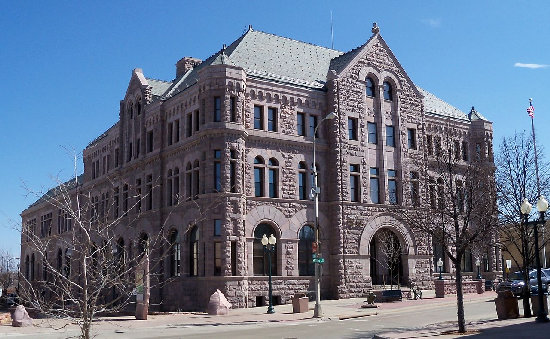
Sioux Falls Federal Building - Source WikiPedia

Blue Mounds State Park is only 20 miles north of Luverne so we arrived in short order.
We stopped at the visitors center and looked around. I got a map and some other material and Betsy bought postcards.
After reviewing the map we decided to take a loop hike which included the Mound and Upper Cliff Trails.
According to local folklore the mound was used as a buffalo jump before European settlement, but no archaeological evidence has yet been found as verification. The soil of the mound was too thin and boulder-strewn for farming, saving it from the plow, although it was grazed.
Parkland was originally established north of the Blue Mound for the purpose of providing work relief during the Great Depression and water recreation. WPA crews built two dams on Mound Creek, creating Upper and Lower Mound Lake — 18 acres (7.3 ha) and 28 acres (11 ha) respectively — and facilities such as picnic grounds and a beach house. The 195-acre (79 ha) Mound Springs Recreational Reserve opened in 1937. In the 1950s trees were planted around the lakes and campground.
Land was added in 1955 and 1961, at which point the name was changed to Blue Mounds State Park. More lands were authorized in 1963 and 1965 to include the whole of Blue Mound and property to either side. The state bought Frederick Manfred's house in 1972 to turn into an interpretive center, although they let him live there for three more years. Because the house was at the southern end of the mound and the developed part of the park was at the north end, a connecting road was surveyed across the top. Local conservationists argued the state out of this plan several times in the 1970s, citing the impact to the environment atop the mound. In 1986 a road was paved from the house south to a county highway instead, so that visitors to the interpretive center must hike in from the north or drive around the edge of the park to the south entrance.
Source: WikiPedia

Blue Mounds is well known for its Buffalo herd which was established in 1961 with 3 animals. The herd has prospered and there are several new calves this year.

This shot is looking down the mowed path of the Mound trail. On the left can be seen the fence of the buffalo enclosure. The grass seen here is probably Big Bluestem.

There are places in the park where you can see into two other states - Iowa and North Dakota. The first white people to see this area must have been awestruck by the vast, treeless plain which extended for 100s of miles in all directions.
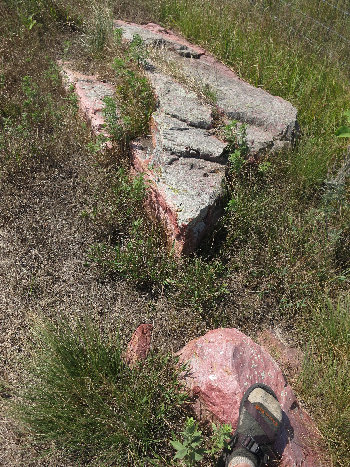
And here is the famous Sioux/Pink Quartzite.

Besides surface pavement and small blocks, there were some good sized boulders strewn about as well.

This beautiful prairie soil is enough to make me start slobbering. Loose, friable and composed mostly of organic material, this stuff would support anything it seems. But the rainfall is so low here it cannot support a forest and there are only scattered islands of trees.

This section of quartzite was laid out like a sidewalk.

This is not a very good photo, but if you click for the high resolution image you will see a small, moss like planting growing along side the cactus. That small plant is a fern "ally" which goes by the common name of Spikemoss (Selaginella). As one might guess, these little plants have adapted to extended dry periods. I have seen Selaginella in many states but never grown side by side with cactus!
There were several interpretive signs near the trail intersection at Eagle Rock. It gives one a glimpse of a by gone era.
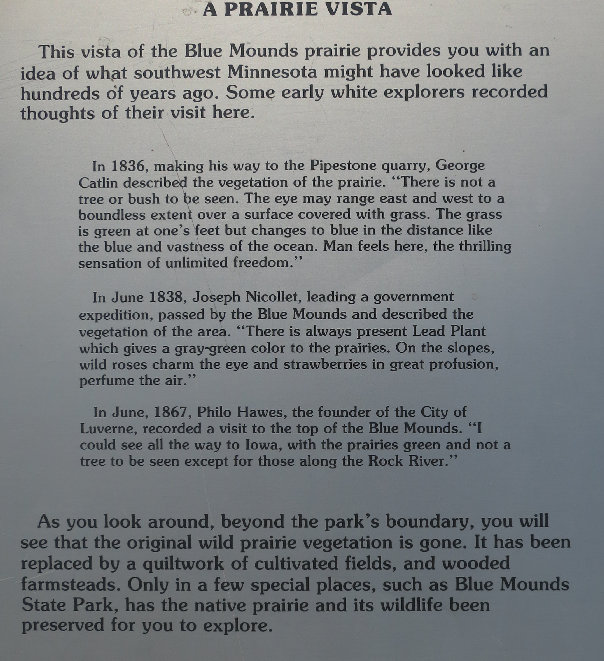

Why I did not take a pic of Eagle Rock, I do not know. I have to admit, the elevation stated here surprised me. When I am travelling these wide open spaces, I seldom have a feeling I am gaining elevation.
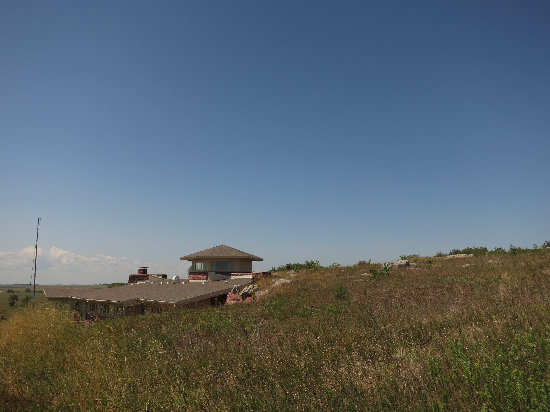
At Eagle Rock the trail descends down the hill to the Nature Center which is built into the hillside. When we saw it was open, we decided to take a look around.
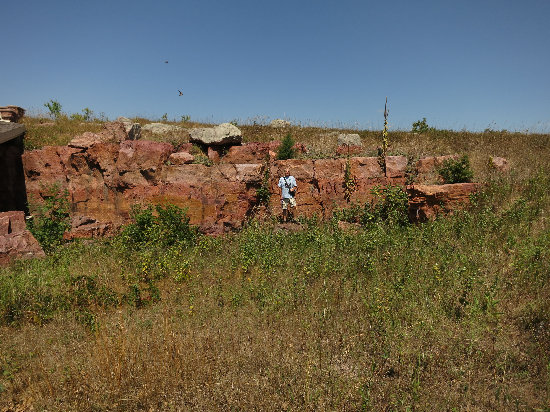
Here is a face which was exposed when the site was quarried. The Nature Center was the former home of Frederick Manfred.
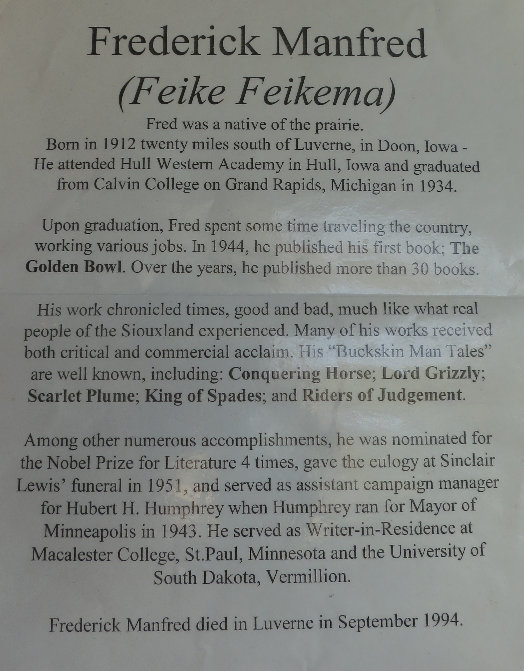
I am not the literary type so I had never heard of this guy. But, he was apparently a well known author and he had a deep love for the prairie and its inhabitants.
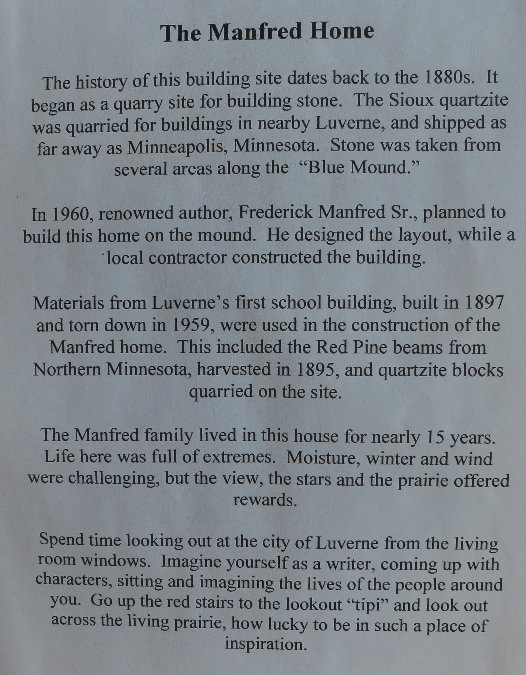
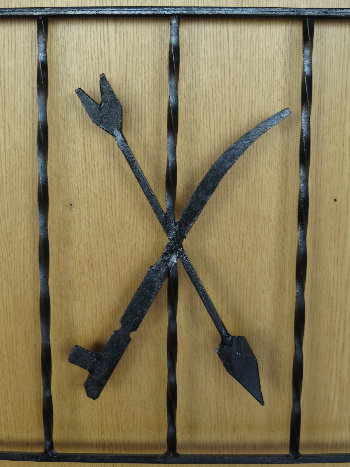
While walking through the house I thought of Frank Lloyd Wright's "Fallingwater" which also has many, many unique and distinctive construction and decorative aspects to it such as the custom made, wrought iron railing shown above.
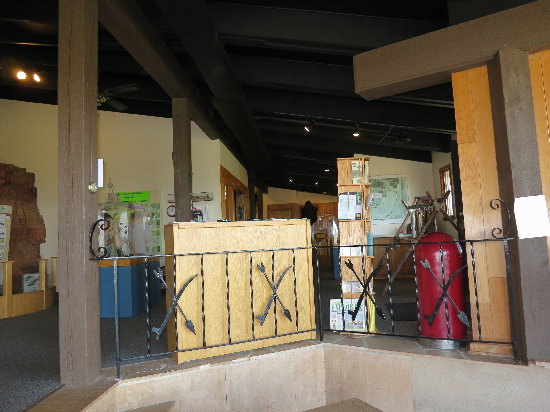
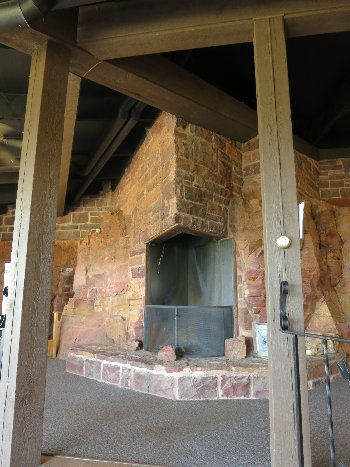
The fireplace was the focal point of the house and blended into the natural rock face which comprised the back wall.
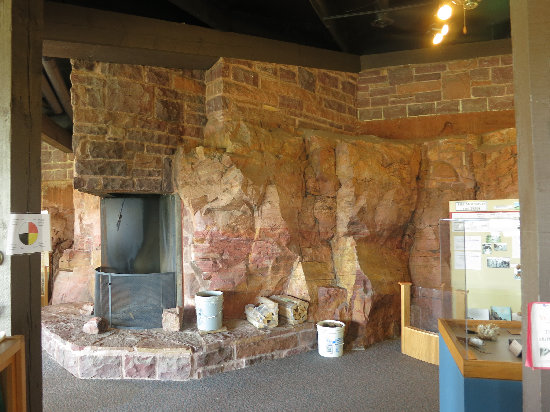
What an interesting place to call home.
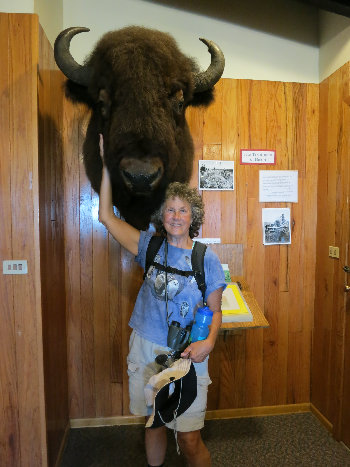
This shows pretty clearly the size of a buffalo. They once roamed the prairie by the 10s of millions. Below is a mountain of Buffalo skulls.
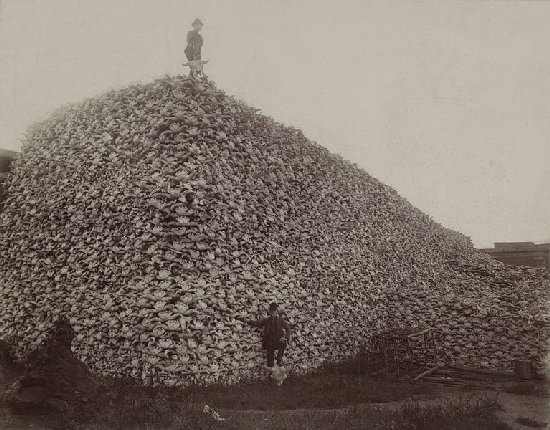
The commercial take arguably was anywhere from 2,000 to 100,000 animals per day depending on the season, though there are no statistics available. Source: WikiPedia
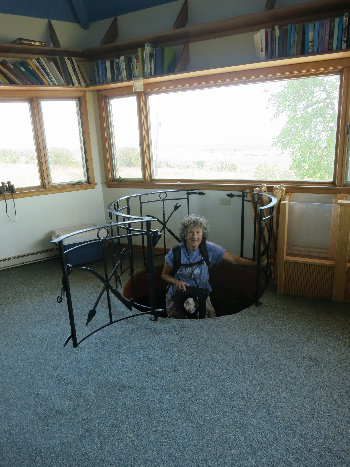
Here, Betsy ascends up a tight, narrow set of winding steps into what Manfred called his Tipi.
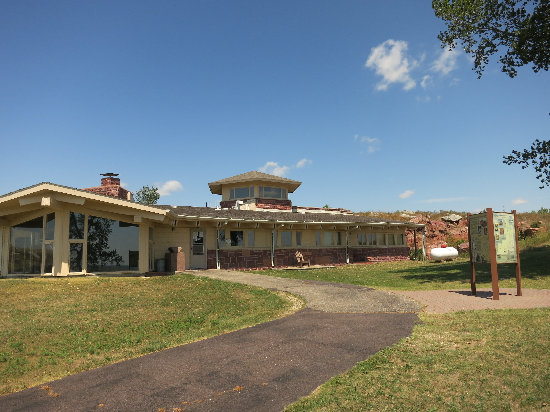
A look at the Nature Center with Manfred's "tipi" in the center. Cool place and a must see.

When we left the Nature Center we then detoured from our original plan and hiked down the Burr Oak Trail. We were very glad we did as there were many beautiful old and gnarly oak trees and some much welcomed shade.

The trail meandered down the hill through the oaks and along the cliff face.
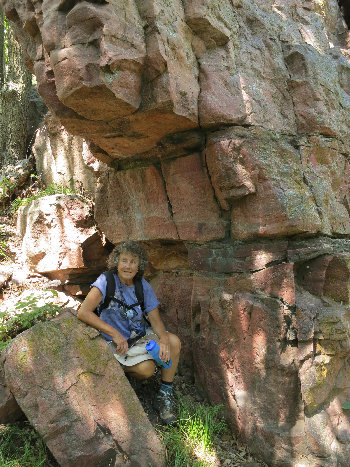
There were some cool overhangs, ledges and crevices.
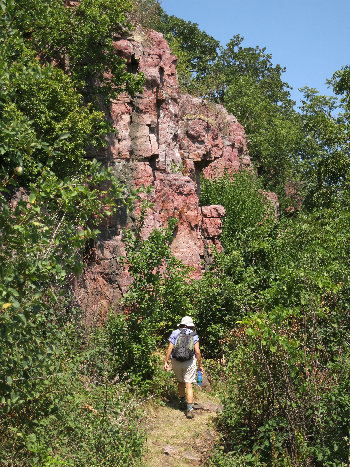

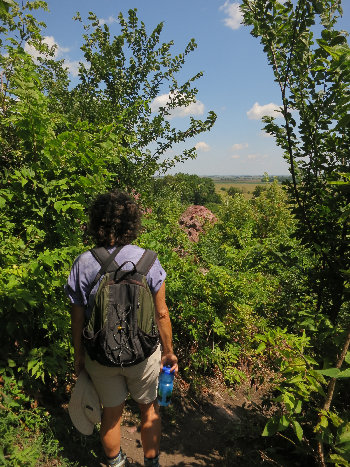
In a few places we could get a peek of the vista off into what was once an unbroken prairie.
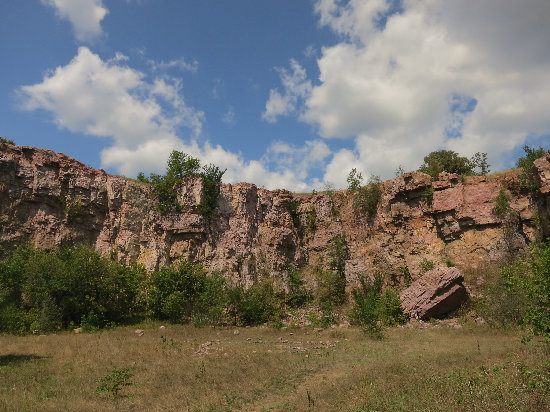
The trail went by the old quarry. If you look closely you can see Betsy in the lower right hand corner. I could not verify this, but this may have been the site of the so called "WPA Quarry" which was used by the Works Project Administration for local projects.
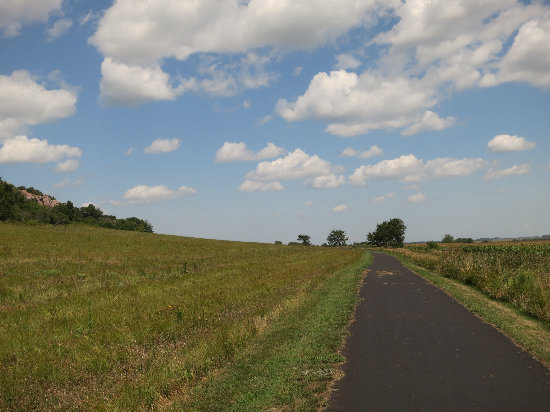
The trail continued on down the hill and then intersected with the 2.2 miles of paved bike trail. We walked this for about a half mile then cut back up the hill, through the woods and back on to the open Upper Cliff Trail.
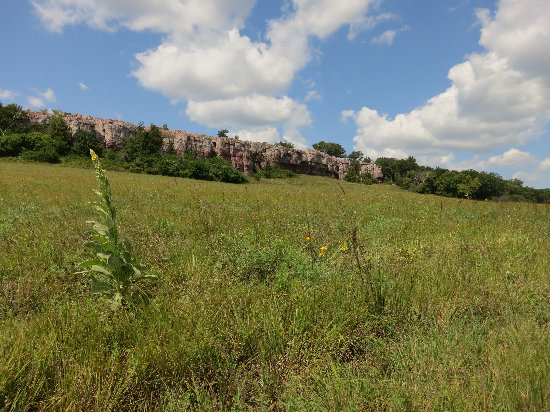
These rock faces are popular with climbers.

Here, Betsy makes a desperate attempt to keep this rock stack form falling over. She strong, - like bull!
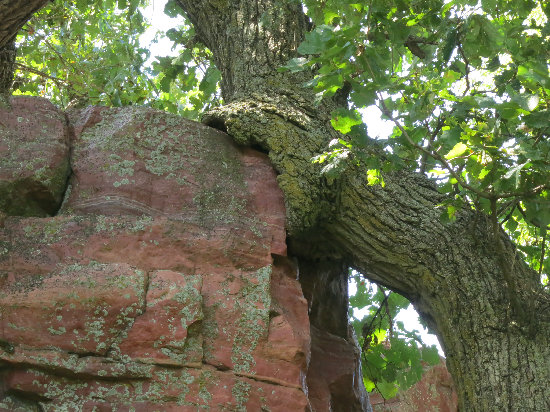
Back into the oakey woods again where we saw this tree trying to eat a rock.

Pretty wild!
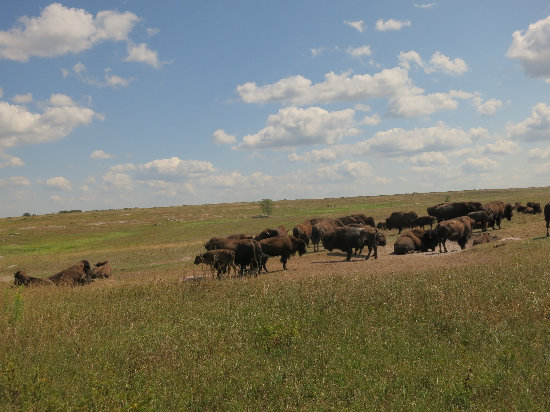
On the way back to the van, we saw the Bison herd had moved very close to the observation deck and we got a really good look at them.
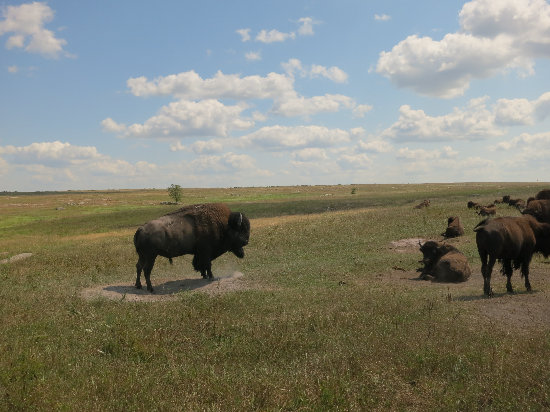
This big old bull appeared to be guarding his favorite wallow.

Husky fellow. He had a scrotum about the size of a soccer ball!

Our last look at the herd before saying good-bye.
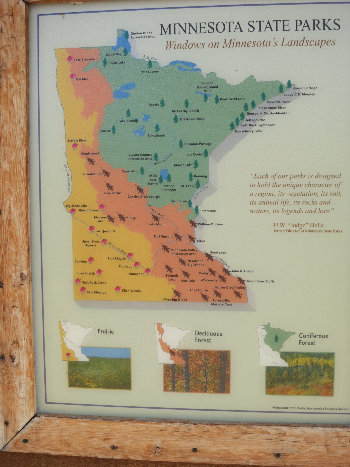
Being so close to Split Rock Creek, I suggested we now head up that way for a look see. Betsy was not too crazy about more hiking so when we got there she went for a dip in the lake and a snooze on a nearby bench. Meanwhile I went for a short walk on one of the few trails to check out the campground and other area of the park.
The map above is a nicely graphic representation of State Park distribution and which biome they are in. Click on it and take a look.
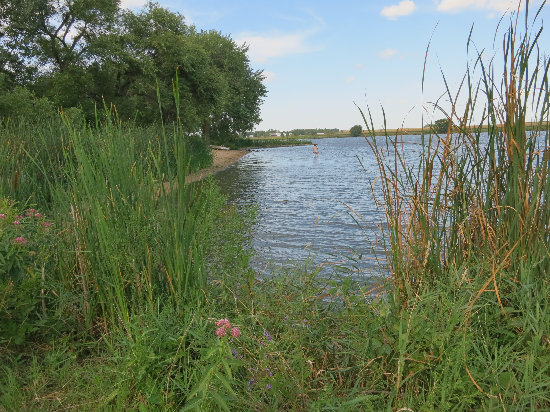
This is the swimming area at Split Rock Creek State Park. Betsy is seen here testing the waters. She said it was so shallow you had to lay down to get fully submerged.
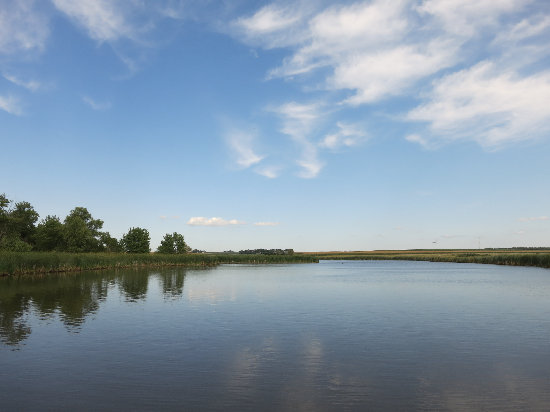
This is the view from one of several fishing piers near the campground, which, by the way was nearly empty. Then it was back to the hotel for Happy Hour.
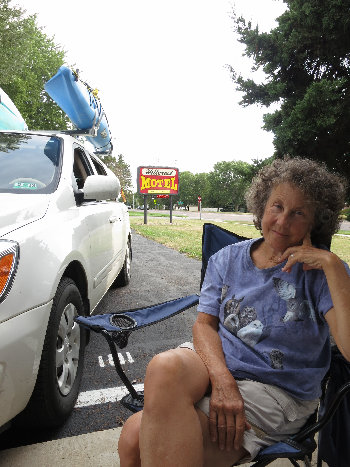
We made ourselves a semi-private place by setting up our Happy Hour Station and Dining Room between the van and a large juniper tree.
After a supper of salad, keilbassi and baked beans, we retired for the evening.
Tomorrow we would explore more of the Sioux Quartzite region.